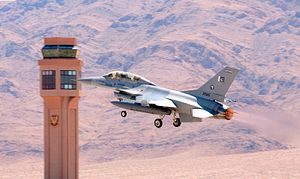Pakistan’s Defense Secretary, retired Lieutenant General Alam Khattak, informed the Senate of Pakistan’s Standing Committees on Defense and Foreign Affairs that the purchase of eight U.S.-made F-16C/D Block-52 fighter aircraft is now a “closed chapter,” according to local media reports.
“The case for the purchase of F-16s from the US is closed, we are now going for a third party transfer of F-16s and have an offer from Jordan,” Khattak said on Monday. Jordan offered Pakistan 16 used F-16 Block-30 fighter aircraft, an older F-16 version than the variants originally offered by the United States.
This would not be the first Pakistani purchase from the Royal Jordanian Air Force (RJAF). In February 2014, Pakistan placed an order for an entire squadron of 14 (some sources say 13) F-16 A/Bs with the RJAF. Delivery of the F-16 aircraft began in April 2015.
The defense secretary admitted during his briefing that the aircraft offered by Jordan are of inferior quality and standard in comparison to the F-16s offered by the United States.
The RJAF F-16 aircraft were built in 1989/90 and underwent a major upgrade in the early 2000s. Should Pakistan decide to procure the squadron of F-16, the aircraft would likely need to undergo an additional major overhaul.
However, Pakistan is looking for a quick replacement given that a number of older F-16 models in service with the Pakistan Air Force will need to be phased out in the near future. The deal is still subject to U.S. approval.
U.S. lawmakers have stalled financing for the eight F-16 Block-52 fighters under the so-called Foreign Military Financing (FMF) for the last couple of months. As I reported previously:
In February, the U.S. State Department approved the possible sale of the F-16 fighter jets to Pakistan. However, fierce congressional opposition repeatedly delayed the signing of a final contract, and in the first week of May U.S. State Department spokesman John Kirby, announced:
While Congress has approved the sale, key members have made clear that they object to using FMF (foreign military financing) to support it. Given Congressional objections, we have told the Pakistanis that they should put forward national funds for that purpose.
Pakistan was expected to pay $700 million instead of the original $270 million for the eight F-16 fighter jets—a price increase of two-and-a-half times the original cost. As a consequence, ever since the U.S. State Department announcement it was highly doubtful that the Pakistan would go ahead with the purchase.
During his briefing, Khattak also confirmed that Pakistan is still considering other options, including French, Chinese and Russian aircraft. Possible aircraft types under consideration are the Chinese-made Chengdu J-10 lightweight and J-20 stealth fighter aircraft (still in the development stage), as well as Russian Sukhoi Su-35S multirole fighter jets.
However, as I reported previously (See:”Blocked F-16 Deal: Pakistan Threatens to Buy Chinese or Russian Fighter Aircraft”):
[I]t is even more unlikely that Pakistan will induct new fighter aircraft types such as the Chengdu J-10 or Sukhoi Su-35 into the PAF, given the logistical difficulties, extra maintenance cost, and additional training requirements that a new fighter aircraft acquisition would entail.
Overall, the Pakistan Air Force currently fields around 70 F-16 aircraft of all variants. Should the F-16 deal with Jordan go through, rather than opting for another foreign fighter aircraft, the PAF will likely purchase additional Pakistan Aeronautical Complex/Chengdu Aerospace Corporation (PAC/CAC) JF-17 Thunder combat aircraft of which it already operates around 60.































